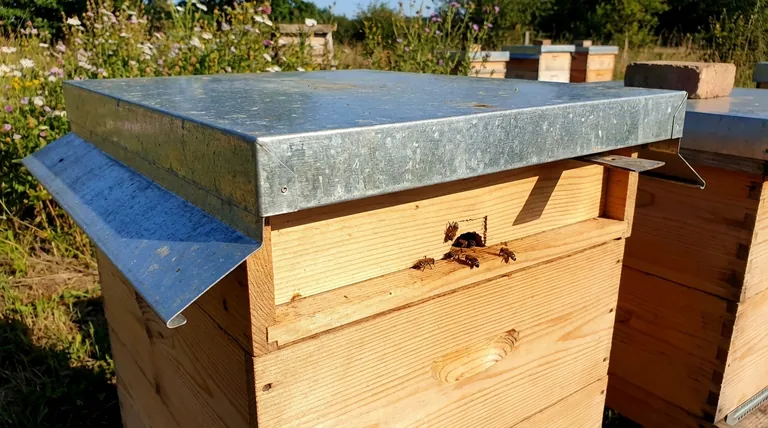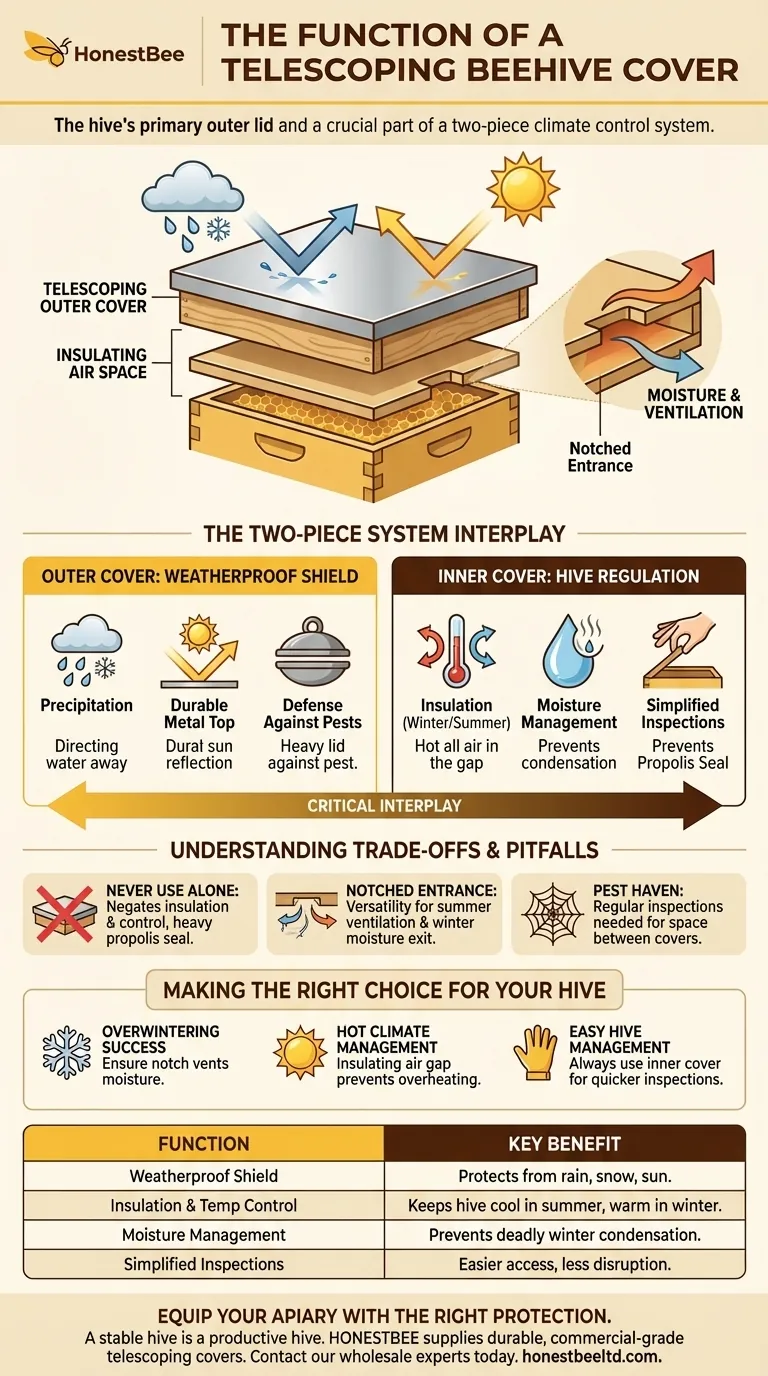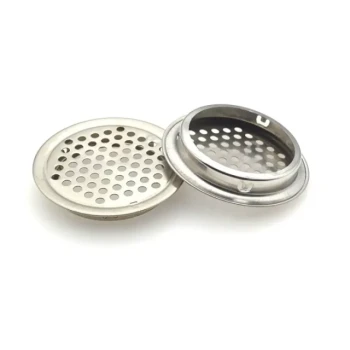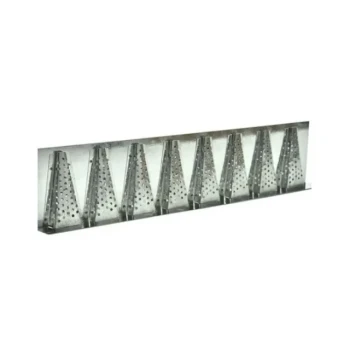In beekeeping, a telescoping beehive cover is the hive's primary outer lid, designed to protect the colony from the elements. Its key feature is its "telescoping" design, where the sides extend down over the top edge of the uppermost hive box. This, combined with a weather-resistant metal top, creates a durable, protective shield against rain, sun, and snow.
While the telescoping cover acts as the hive's weatherproof "roof," its true function is as part of a two-piece system. The health and stability of the hive—managing moisture, temperature, and beekeeper access—is controlled by the critical interplay between this outer cover and the inner cover beneath it.

The Outer Cover's Primary Role: A Weatherproof Shield
The most visible job of the telescoping cover is to provide robust, external protection. It is the first line of defense against environmental stressors.
Protection from Precipitation
The cover's sides overhang the hive body by several inches. This design ensures that rain and melting snow are directed away from the hive's seams, preventing water from leaking into the colony.
The top is covered with a sheet of galvanized metal. This material is not only waterproof but also highly durable, reflecting sunlight and resisting weathering over many seasons.
Defense Against Sun and Pests
In hot climates, the cover shields the colony from direct, intense sunlight, helping to prevent the hive from overheating.
Its solid, heavy construction also provides a secure barrier against larger pests or predators that might try to gain access from the top.
The Inner Cover: The Unsung Hero of Hive Regulation
The telescoping cover rarely works alone. It is designed to be used with an inner cover, a flat wooden board that sits directly on top of the uppermost hive box. This component is essential for fine-tuning the hive's internal environment.
Creating Insulating Air Space
The inner cover creates a pocket of "dead air" between itself and the outer telescoping cover. This air space acts as a crucial layer of insulation.
In the summer, it helps keep the hive cool. In the winter, it helps retain the colony's warmth and reduces heat loss.
Managing Moisture and Ventilation
A key function of the inner cover is moisture management, which is critical for a colony's winter survival. Warm, moist air produced by the bee cluster rises. Without an inner cover, this air would hit the cold surface of the outer cover and condense, dripping cold water back onto the bees.
The inner cover provides a warmer surface, and most designs include a small, notched opening. This notch can be used as an upper entrance for the bees or, more importantly, as a vent to allow excess moisture to escape the hive.
Simplifying Hive Inspections
Bees use a sticky substance called propolis to seal all cracks and gaps within their hive. Without an inner cover, they would firmly glue the telescoping cover directly to the hive body.
The inner cover prevents this, making it far easier for a beekeeper to open the hive. You only need to break the weaker seal on the lightweight inner cover, causing less disruption and stress to the colony.
Understanding the Trade-offs and Pitfalls
Using this two-part system correctly is vital. Misunderstanding its function can lead to common problems that harm the colony.
Never Use an Outer Cover Alone
A frequent mistake by new beekeepers is omitting the inner cover. This completely negates the benefits of insulation and moisture control.
It also guarantees the outer cover will become heavily sealed with propolis, making hive inspections difficult and damaging to the equipment when pried open.
The Notched Entrance
Most inner covers have a notch on one edge. This provides versatility for ventilation. In summer, this can offer an additional entrance to reduce congestion at the main entrance.
In winter, a small upper entrance is critical for allowing moisture-laden air to exit, preventing the deadly condensation that can chill a cluster.
A Potential Haven for Pests
The space between the inner and outer cover can occasionally become a home for pests like wax moths or spiders. Regular inspections are necessary to ensure this area remains clear.
Making the Right Choice for Your Hive
The cover system isn't just a lid; it's a climate control system. How you use it depends on your specific goals and local environment.
- If your primary focus is overwintering success: Use both covers, ensuring the inner cover's notch provides a small upper vent for moisture to escape.
- If your primary focus is keeping bees in a hot climate: The insulating air gap between the two covers is your best defense against overheating.
- If your primary focus is easy hive management: Always use an inner cover to prevent the outer cover from being sealed shut, allowing for quicker and less disruptive inspections.
Ultimately, viewing the telescoping and inner covers as an integrated system is the key to maintaining a stable, healthy, and productive colony.
Summary Table:
| Function | Key Benefit |
|---|---|
| Weatherproof Shield | Protects hive from rain, snow, and sun with a durable metal top and overhanging sides. |
| Insulation & Temperature Control | Creates an air gap with the inner cover to keep the hive cool in summer and warm in winter. |
| Moisture Management | Prevents deadly condensation in winter, crucial for colony survival. |
| Simplified Hive Inspections | Prevents bees from gluing the main outer cover shut, making inspections easier. |
Equip your apiary with the right protection. A stable hive is a productive hive. HONESTBEE supplies durable, commercial-grade telescoping covers and essential beekeeping equipment to commercial apiaries and distributors. Ensure your colonies thrive in any climate—contact our wholesale experts today to discuss your needs and bulk pricing.
Visual Guide

Related Products
- Professional Hive Top Bee Feeder for Beekeeping
- Professional Insulated Winter Hive Wrap for Beekeeping
- HONESTBEE Professional Hive Top Bee Feeder Feeding Solution
- Inner Beehive Cover for Beekeeping Bee Hive Inner Cover
- Stainless Steel Round Beehive Air Vents for Ventilation
People Also Ask
- Why is a top feeder essential for bees? Ensure Colony Health and Efficiency
- How to use a top feeder in a beehive? A Guide to Effective Beehive Feeding
- What are the features of top feeders for bees? Maximize Hive Health with Safe, High-Capacity Feeding
- Do I need an inner cover with a hive top feeder? Optimize Your Hive Setup for Healthy Bees
- How is the plywood floor fitted into the hive-top feeder? Ensure Longevity with a Floating Floor Design



















